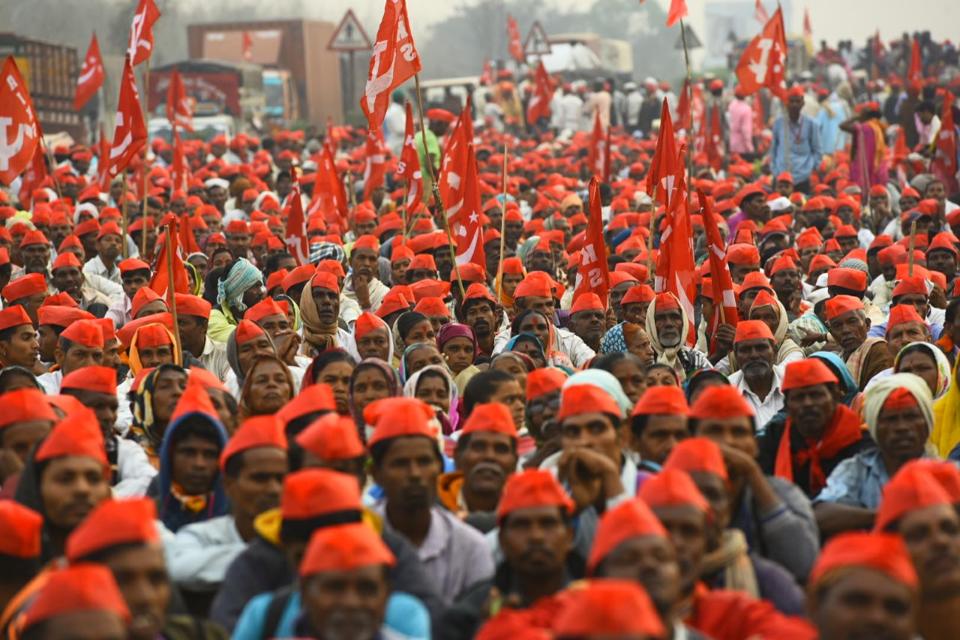Maharashtra’s farmers protest
March 12, 2018 | Expert Insights

A protest march of 30,000 farmers reached India’s financial capital of Mumbai on Sunday. The farmers are protesting for land rights and monetary assistance from the state government. Maharashtra officials have agreed to meet representatives.
Agriculture is the livelihood of approximately 47% of India’s population. The agricultural sector faces numerous problems and farmers often face crippling debt.
Background
India is the world's seventh-largest economy by nominal GDP. It has an enormous labour force of approximately 521.9 billion, with a majority (approximately 47%) employed in the agricultural sector. However, as of 2016, agriculture and related sectors contributed only 16.8% of the country’s GDP.
India has a history of agricultural movements beginning in the 1970s. Commonly called the “new farmers movements”, these movements involved widespread protests and the formation of farmers’ organisations. The key aim of these protests was to modify the state’s intervention in the agrarian economy. Common demands included lowing costs for inputs (such as seeds, fertilisers, water, and electricity), and higher selling prices.
The Swaminathan Commission Report was a product of the National Commission on Farmers (NCF), intended to address farmer suicides in India. The report concluded that the major causes of the agrarian crisis in India are: poor land reforms, lack of agricultural infrastructure and technology, access to water, “access, adequacy and timeliness” of credit, weather conditions, and the marketability of agrarian goods. The report made a number of recommendations towards food security, agricultural productivity, and ecological sustainability.
Agriculture was a huge focus in the 2018 budget. The government stated that it hopes to double farmer incomes by 2022. The Minimum Support Price for a number of crops was increased, and measures promoting agricultural commodities and exports were announced.
Maharashtra in western India is the third largest state in India. As of 2014, agriculture and allied sectors contributed approximately 13% of the state’s income. Additionally, over half the population of the state is rural. In June last year, Maharashtra saw widespread protests when officials refused to announce a complete reversal of loans for every farmer, as had been promised. The protests were called off after the Chief Minister agreed to write off loans with a cap of 1.5 lakh rupees.
Analysis
Over 30,000 farmers marched into Mumbai, the capital of Maharashtra, on Sunday. The farmers had walked for 6 days from Nashik district, over 170 kilometres away. The march was led by the All India Kisan Sabha (All India Peasants Union).
The protest stems from dissatisfaction with the government. One of the key grievances involves crop prices. “Agricultural income has swiftly declined in the country," one of the leaders, Vijay Javandhia told BBC Marathi. "Income in cotton, grains and pulses is declining day by day. That's why the rural economy is gradually running out of money.”
Farmers have claimed that the loan waiver promised by the state last year had not reached a number of farmers. They demanded financial assistance in light of failed crops last month. A number of Adivasi (tribal) protesters are also rallying for land rights. Lands that have been historically cultivated for generations by Adivasis still come under the Forest Department. The Forest Rights Act of 2006 attempted to address forest dweller’s rights, however, it has been criticized as ineffective and inadequate.
“The state government has started discussions with us. We will not end our protest until they give us written assurances around fulfilling our demands,” said Ajit Nawale, state general secretary of the All India Kisan Sabha.
The government has stated that it is willing to hold talks to end the protests, and a number of farmers met with a government panel on Monday. “The government is sensitive and positive towards the protests. When this protest march was about to begin, [government officials] spoke to the farmers and tried to dissuade them from starting the protest march. The government tried to start a dialogue with the farmers but they were adamant to start a protest march,” Chief Minister Devendra Fadnavis said. Opposition parties have expressed support for the protesters.
The protests have also gained attention due to the positive response from Mumbai’s residents with a number of bystanders joining the march. Citizens have provided food to the protestors as well.
Assessments
Our assessment is that farmers across India face major issues of debt; this is a social concern that has not been adequately addressed. We believe that the Indian agricultural sector faces a crisis of sustainability and productivity. The Swaminathan Commission Report may serve as a starting point for agricultural reform. Additionally, the current protests may present a challenge to the ruling BJP coalition, which will face elections in 2019.








Comments